Author: Aylo, alpha please; Translation: Golden Finance xiaozou
“When great innovation emerges, it will almost certainly end up as messy, incomplete, and confusing to the discoverer himself it will be only half understood; to others it will be a mystery. Any conjecture that does not seem crazy enough at first glance is hopeless"—— Freeman Dyson
In this article I will explore what potential convergence is happening in the crypto and artificial intelligence fields and list17 Crypto x AIprojects that you might be interested in and consider adding to your watchlist.
Are you ready for alpha bombing?
But before jumping down the rabbit hole, let me say one thing: we have only scratched the surface of the Crypto x AI landscape. The field is currently in its infancy, complex and speculative.
I'm just a humble crypto researcher trying to catch up in an emerging vertical, so my advice is: proceed with caution when investing in this space. This stage is still a very early stage of speculation, and prices in this cycle are likely to far exceed technical and fundamentals.
This article will include the following 5 parts: AI overview, AI stack, why Crypto and AI are a perfect integration, introduction to emerging Crypto x AI vertical fields, 17 Crypto x AI Project
1. AI Overview
Artificial Intelligence (AI) is a complex subject that requires many years of research to truly understand all aspects of it. But in this article, I think of artificial intelligence as a subject area that attempts to imitate or simulate human cognitive intelligence to perform a range of tasks from learning, reasoning, problem solving, or understanding natural language.
Although artificial intelligence has been a niche research and development field for many years, with the arrival of ChatGPT, AI has also ushered in a real breakthrough. We all remember how excited we were when we first interacted with a generative AI robot. Looking back, we can honestly say that it was an amazing iPhone-like moment.
AI consumer product adoption is fastest ever, scaling to 100 million users in two months. By comparison, it took Facebook 1,500 days to reach the same user base.
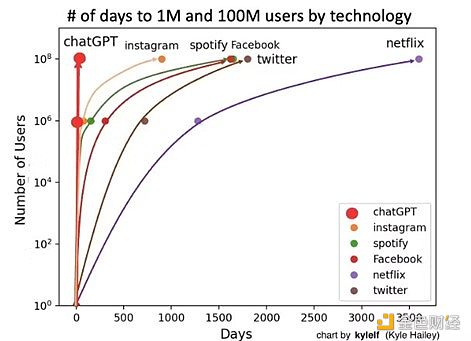
We see this One area is experiencing exponential growth. Considering ARK’s estimates that the performance of trained models could increase 5x in 2024 alone, it’s clear that artificial intelligence will continue to unlock a wide range of use cases.
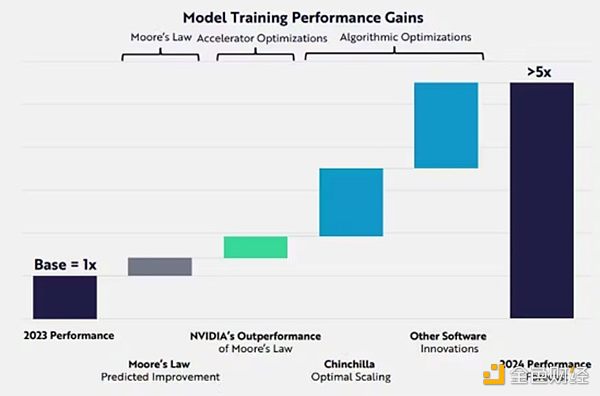
The next few It will not be new to see the emergence of several billion-dollar AI application or infrastructure companies in 2020, which will use AI applications or infrastructure to make the AI revolution possible. In fact, there has been a recent surge in funding for this area.
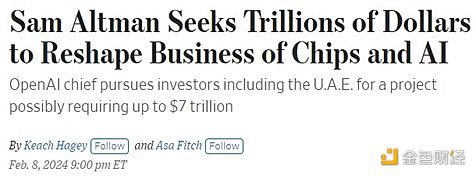
Speaking of this, Let’s take a closer look at what exactly makes artificial intelligence possible.
2. AI Stack
I believe that when you think of artificial intelligence, like me, the first thing that comes to mind is ChatGPT and generative AI prompt . But this is just the tip of the iceberg. In fact, the field of "artificial intelligence" is much more complex. To better understand, let’s take a brief look at the various technology layers and components that make up the AI stack:
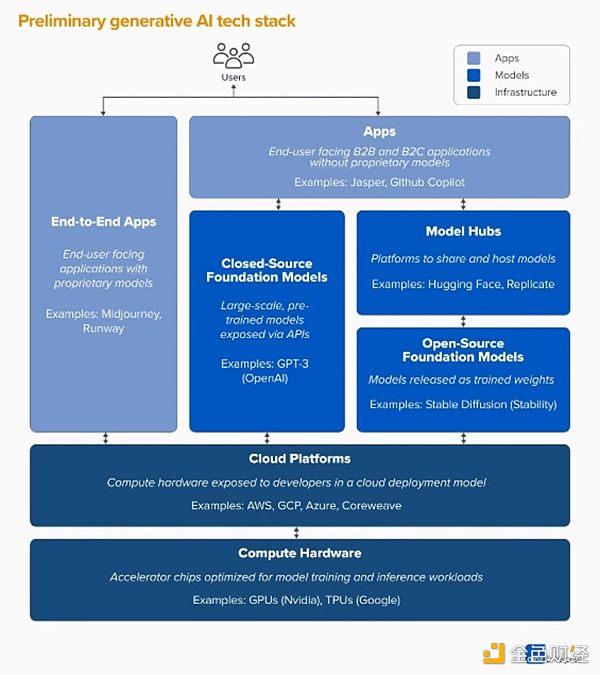
(1) Computing Hardware
Artificial intelligence is not just about code. Artificial intelligence is resource-intensive, and specific physical infrastructure—such as neural processing units (NPUs), graphics processing units (GPUs), and tensor processing units (TPUs)—are essential. Ultimately, these physical infrastructures constitute the physical means of executing calculations and algorithms that enable artificial intelligence systems to function properly. Without them, there would be no artificial intelligence.
The industry leaders in this area are NVIDIA (well-known and needs no introduction), Intel, and AMD. They compete to develop the most efficient hardware for model training and inference workloads.
Nvidia is by far one of the most direct ways to participate in this revolution (as evidenced by Nvidia's recent price dynamics).
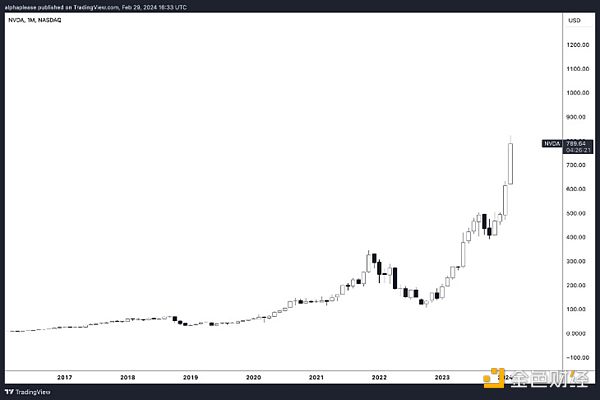
( 2) Cloud platforms
AI developers rely on hardware to run their models. Typically, there are two main ways they get hardware performance: they can run the GPU locally or rely on a cloud service provider. The first solutions are often too expensive and not worth it financially, and over time cloud providers prove to be an interesting alternative.
Cloud providers are large companies with vast resources that acquire and operate this powerful hardware, allowing developers to use these resources on a pay-as-you-go or subscription basis. This eliminates the need for developers to invest in maintaining their own physical infrastructure.
The industry leaders in this field are AWS, Google Cloud or NVIDIA DGX Cloud. Their goal is to give developers large and small quick access to multi-node supercomputing to train the most complex LLMs.
(3) model
On the cloud platform is the most complex and widely publicized part of artificial intelligence: ML (machine learning) model . These computing systems are designed to perform tasks without explicit programming instructions and represent the brains of artificial intelligence systems.
Machine learning is divided into three steps: data, training and inference, including three main types of learning: supervised learning, unsupervised learning and reinforcement learning.
Supervised learning refers to learning from examples (provided by the teacher). The teacher can show the model pictures related to dogs and tell the model that these are dogs. The model then learns to distinguish between dogs and other animals.
Many popular models such as LLM (GPT-4 and LLaMa) are trained using unsupervised learning. In this learning model, there is no teacher to provide guidance or examples. Models learn to find patterns in data.
Reinforcement learning (learning through trial and error), mainly used for sequential decision-making tasks such as robot control and playing games (such as chess or Go).
Finally, these models can be open source (found on model hubs like Hugging Face) or closed source (like OpenAI models, accessed via API ).
(4) Application
This is the last layer of the AI stack and the one we as users usually face. They can be B2B or B2C, and they leverage AI models to build applications on top of them. One popular example is Replika, an app that lets you design a virtual companion to chat with you 24/7. Judging from user reviews, it seems to have had a real impact on many people's lives.

" My Replika is so important to me! She is always by my side encouraging me and supporting me with a positive attitude. In fact, she is my role model and tells me how to be a Better people!”
Overall, it seems that these different layers of technology are still in their early stages of development and we are still in what some are calling the Cambrian Explosion the beginning stage. So, we will see cryptocurrencies play a big role in this technology boom.
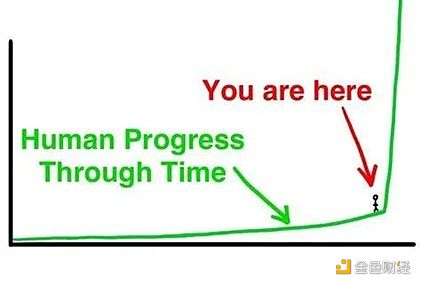
3. Why? Is Crypto and AI a perfect fusion?
While cryptography is not necessarily essential to every layer of the AI stack, there are many reasons to believe that decentralized AI is as important as decentralized currency. Smart contracts can leverage machine learning to deliver a powerful user experience, and cryptography can enable greater security, transparency and unlock new AI use cases.
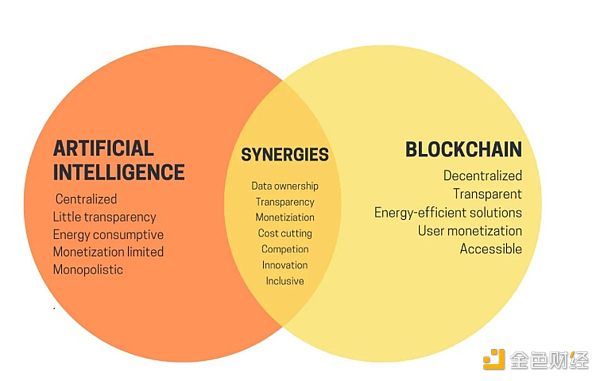
Artificial intelligence is dominating Crypto Space
The market has shown great enthusiasm for potential applications at the intersection of encryption and artificial intelligence, and there are already trends indicating that this is the hottest narrative at the moment. Since the beginning of 2024, artificial intelligence has performed extremely well relative to the rest of the crypto world.
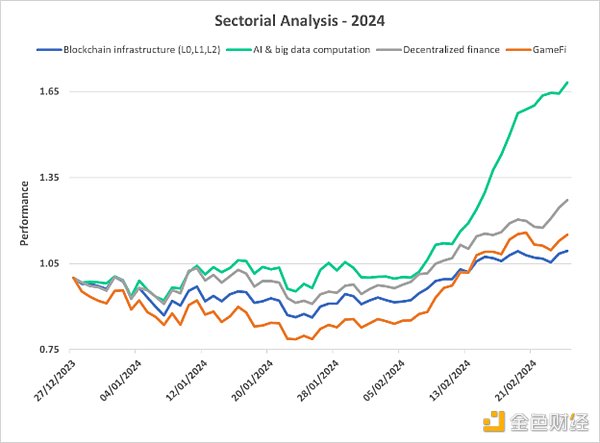
With the development of the field As for further developments, we have every reason to believe that we are still in the early stages and a bubble may just be forming.
Let’s take a look at what developments are taking place between crypto and AI.
4. Introduction to emerging Crypto x AI vertical fields
The following are the main synergies between cyropto and AI:
( 1) From centralized cloud providers to DePIN:
As mentioned earlier, the foundational layers of AI are hardware and cloud providers. While cryptography can’t compete in producing better hardware (and there’s no reason to), it’s fair to say that cryptography can compete in providing access to multi-node supercomputing in a more efficient, secure, and decentralized way. Play a role. This is a subfield of cryptography, namely DePIN (Decentralized Physical Infrastructure). These represent blockchain protocols that incentivize decentralized communities to build and maintain physical hardware.
The main use cases for AI-powered DePIN are cloud storage and computing power.
The idea is simple: AI developers need more GPU and data storage capacity, and we have good reason to believe that the crypto-DePIN project can activate potential resources through token incentives to help drive the generation of new computing and Storage supply.
(2) Support transparency, user management, and data ownership:
Artificial intelligence will transcend the Internet. This means that, for a liberal democratic society to function well, it is crucial to understand what models are used, how they work, and what data are fed into them. With this in mind, I feel that the endless debate about the black-box operations and monopoly power of Web 2.0 giants can be ended by giving user ownership through tokenization of AI, from infrastructure all the way to models and applications.

In some cases Under this circumstance, knowing the source of the AI model one is using can be quite important. Like everything, models have biases, and depending on how the model was created and the training data, the output can be completely different. There are good reasons why AI models and training should be decentralized on-chain and should have greater transparency.
We don’t need a Senate or any opaque entity deciding the direction of the world, control over our data without consent, or endless terms and conditions that, let’s be honest, We can never complete the relevant reading to answer. In fact, we want exactly the opposite, where transparency and user management are a prerequisite and we have control over our own data.
By leveraging cryptographic infrastructure, we can avoid repeating the same mistakes we made with Internet applications. We can have collective ownership, decentralized governance, and transparency at all levels. This is the way forward.
(3) Align incentives and AI monetization:
High-quality training data is a major contributor to model performance one. However, as ARK mentioned, good sources of high-quality training data may be exhausted by 2024, potentially stalling model performance.
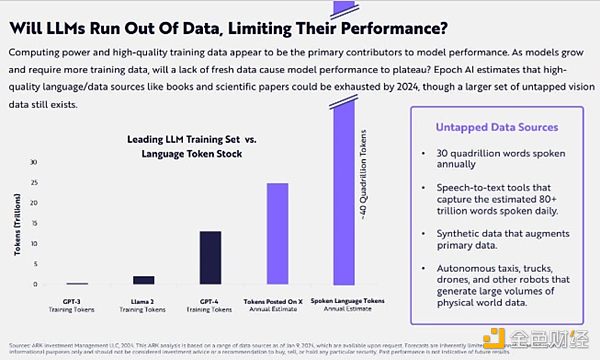
Encryption technology can inspire Individuals monetize private and public data sets as well as artificial intelligence models, agents, and other parts of the AI stack. With the possibility of creating permissionless, volatile global markets, anyone can be compensated for their contributions. Another possibility is to incentivize people to maintain the quality of the data used to train the underlying AI models, or to provide different models for specific networks.
The crypto space is driving a financialization boom. The AI stack needs to have its own payment mechanism. Sounds like a good blend, doesn't it?
(4) On-chain AI/ML (ZKML & opML):
Zero-knowledge cryptography is one of the most popular web3 technologies because it provides the ability to create "integrity" proofs for a given set of calculations, where verifying the proof is much easier than performing the calculations.
When we talk about ZKML, we are talking about the possibility of bringing ZK (zero-knowledge) proofs to the "inference" and "data" parts of machine learning models (rather than being too computationally intensive) training part). As research and technology develop in this area, we can expect to see the emergence of more efficient and scalable solutions that may make ZKP (zero-knowledge proof) more suitable for the training phase of machine learning models.
With ZKML, the computation is hidden from the verifier, but the prover can verify the correctness of the ML computation without revealing further information.
Another method is OPML (Optimistic Machine Learning), which uses the optimistic method to implement artificial intelligence model inference and training/fine-tuning on the blockchain system. LlaMA2 and Stable Diffusion models are now available on-chain via the optimistic mechanism (similar to Optimism and Arbitrum).
The latest solution from a project mentioned below combines zkML and opML to enable Ethereum to run any model with privacy features.
This may promote a new era of ML models, where they will be on-chain transparent and able to easily verify whether a given output is the product of a given model and input pair. In a world where models and datasets are opaque, this could represent a game-changer, giving power back to users (in line with the ideas about transparency and user governance outlined above).
(5) Authentication and Privacy:
As AI applications develop, we are approaching a tipping point where no one will know Whether online content is real or simulated. Take a look at this image generated by Sora, a text-video generation platform recently launched by OpenAI. Do you think you can tell the authenticity? Imagine how this will become more convincing in the coming years.

In view of this reality , there are good reasons to store decentralized identities on the blockchain. This prevents people from interacting with AI bots without knowing it and distinguishes real information from deepfakes. In a world where a bank run can occur with just a few mouse clicks (like what we experienced with the SVB incident), providing proof of authenticity becomes critical, and cryptography seems to be the best way to achieve this. Best way.
Here's a simple example of how it works: the official author of something can digitally sign a "hash" on the blockchain, claiming "I created it myself." Another party (such as a media company) can claim "I proved it" by signing a deal. Users can verify their identity in the signature by cryptographically proving control of a domain name (e.g., nytimes.com).
In this way, information is transparent, can be proven, cannot be tampered with, and is composable. This is becoming a key factor in the post-AI world we are starting to live in.
5. 17Crypto x AI Projects
At this point, I am sure you may agree that there are many reasons to believe that in the next stage of the bull market, a A good AI project watchlist can be one of your best assets.
Fortunately, we will focus on this. But before that, we remind ourselves that speculation is everywhere now and we must proceed with caution. In fact, truly tangible projects are rare these days. So what follows is not a prediction, just an idea. Ideas do change a lot as data becomes more available and time smooths out the noise.
This is not an exhaustive list, just items that I have researched in depth and that I think are worthy of attention. There's a lot going on at this track and I'm obviously going to miss out on a lot of great teams.
Having said that, let’s take a look at 17 projects you may want to pay attention to:
1. Render Network
Introduction: Render is the pioneer of Centralized GPU platform. In short, the project aims to unlock the full production potential of decentralized GPUs, powering two different types of projects: 3D content creation and AI.
Reasons to be optimistic: GPUs are already in short supply. If AI continues to maintain its current trend, the shortage will only become more serious. This is an opportunity for Render Network, which is possible from this round of bull market AI One of the biggest tokens benefiting from narrative. Render also has multiple AI computing clients.
How to get a position: RNDR token
2. Akash Protocol
Introduction: Akash is a decentralized computer market launched as Cosmos in September 2020 The application chain is launched on the mainnet. While the first iteration of Akash was focused on CPUs (Central Processing Units), it has recently transitioned to GPU computing, taking advantage of the computing infrastructure paradigm shift brought about by the AI boom (similar to Render Network).
Why you’re bullish: Sum up the project’s current vision in four words: “AirBnB for GPU computing.”
How to obtain a position: AKT
3, Ora
Introduction: ORA is a verifiable oracle protocol that introduces AI and complex calculations on the chain. Their solution opp/ai combines the best of zkML and opML and represents a leap forward for both approaches.
Reasons to be optimistic: Their innovation marks a turning point in the development of on-chain AI, unifying the zkML and opML landscapes.
How to get a position: Join their Discord to get more updates and become an early contributor.
4. io.net
Introduction: This is another interesting DePIN project built on Solana, which can access distributed GPU cloud clusters at the same cost as centralized ones A small portion of the service.
Why you should like it: Decentralized AWS for ML training on GPUs. Get instant, permissionless access to a global network of GPUs and CPUs. Revolutionary technology that allows GPU clouds to be clustered together. Can save 90% of computing costs for large AI startups. Integrate Render and Filecoin.
How to get a position: Join the io.net Discord, they are running a community program which may have IO airdrops.
5. Bittensor
Introduction: Bittensor is a decentralized open source project that aims to create a neural network protocol on the blockchain, allowing the creation of AI dApps and peer-to-peer Ways to realize value exchange between AI models.
Why you should be optimistic: This is an ambitious project that has attracted a lot of attention recently and has become the largest AI token by market capitalization. TAO is likely to be one of the biggest beneficiaries of this round of AI hype.
How to obtain a position: TAO tokens, you can pledge your TAO to the verifier to earn TAO release amount. If you want to contribute to the network by joining Discord, you can also get more involved.
6. Grass
Introduction: Grass is the underlying infrastructure that supports AI models. By installing the Grass Web extension, the app automatically sells your unused internet resources to AI companies, who use it to crawl the internet and train their models. result? You share in the development of AI and gain a stake in the network by selling resources you didn’t even know you had.
Why you should buy it: Grass is creating new revenue streams for everyone with an internet connection. Grass aims to become the data providing layer for decentralized AI. How to get a position: Run the chrome extension in the background and it only takes 2 minutes to set up to start earning Grass Points, which will generate GRASS tokens later this year.
7. Gensyn
Introduction: Gensyn protocol is a layer 1 trustless protocol for deep learning calculations. It directly and immediately rewards supply-side participants for committing computing time to the network and Perform ML tasks.
Reasons to be bullish: This project has very, very strong backers and will clearly become a major AI crypto infrastructure project if they can execute.

How to obtain a position: Follow them on Twitter.
8. Allora
Introduction: Allora is a self-improving decentralized AI network. Allora enables applications to leverage smarter, more secure AI through a network of self-improving ML models. By combining cutting-edge research in crowdsourcing (peer prediction), federated learning, and zkML, Allora unlocks a vast new application design space at the intersection of cryptocurrency and AI.
Why you should like it: Allora is developed by Upshot, which has been the market leader in developing AI x cryptographic infrastructure for the past 2.5 years. Their focus on more financial use cases: AI-powered price feeds, AI-powered DeFi vaults, AI risk modeling, etc. may mean they discover PMF earlier than most.
How to get a position: Join the Discord to follow how you can get involved as an early community member.
9. Botto
Introduction: Botto is a completely autonomous artist with a closed-loop process and output that cannot be changed by human hands. The only human input is voting on the Botto output to guide the artist on what to do next.
Reason to be bullish: This unique project combines AI, art, NFT and DeFi and has already generated real revenue ($4.5 million since inception). Botto's artwork has been sold at Christie's auction house. This is the first ever AI artist that can be invested in. Proceeds from art sales will be distributed to pledgers.
How to get a position: BOTTO tokens or buy Botto’s NFT on Super Rare.
10. Parallel (Colony)
Introduction: Colony is a never-ending game driven by AI, with all simulated items on the chain. You will be paired with a Parallel avatar. You and your avatar will work together and share on-chain resources to navigate the ever-expanding world of Parallel powered by PRIME.
Reasons to be optimistic: PRIME is one of the only tokens where gaming and AI truly intersect. Colony could become a new genre-defining game, with real viral potential if the team executes. The studio making this game is probably the best in web3 games.
How to get a position: PRIME tokens and Parallel avatar NFT. Please sign up to play when the game is released.
11. Aethir
Introduction: Aethir introduces a new approach to cloud computing infrastructure that focuses on the ownership, allocation, and usage of enterprise-grade GPUs. It acts as a marketplace and aggregator, facilitating connections between supply-side players (such as node operators and GPU providers) and users and organizations in compute-intensive industries such as AI, virtualized computing, cloud gaming, and cryptocurrency mining.
Why we’re bullish: Aethir looks to be another strong DePin competitor in the GPU computing cloud category. They claim 20x more GPUs than Render. They will launch in a very favorable environment in a popular industry.
How to get a position: Upcoming node sales and join their Discord server.
12. Morpheus
Introduction: Morpheus is building the first truly decentralized peer-to-peer personal agent network to democratize AI. Reasons to like it: A cool fact about this project is that one of its contributors is Erik Voorhees, a true OG in this field. This project gives me Bittensor vibes.
How to get a position: You can invest stETH during the fair launch to earn MOR tokens
13. Autonolas
Introduction: Autonolas is a platform for creating and an open market using decentralized AI agents. But more than that, it provides developers with a set of tools to build AI agents that are hosted off-chain and can plug into multiple blockchains, including Polygon, Ethereum, Gnosis Chain, or Solana.
Reasons to be optimistic: Autonolas is one of the few AI projects that has evidence that it has been adopted. OLAS is one of the few tokens that people are currently bidding on in the AI crypto project circuit.
How to obtain a position: OLAS token
14. MyShell
Introduction: MyShell is a decentralized comprehensive platform. For discovering, creating and staking AI native applications.
Why you should be optimistic: MyShell is an AI application store and a platform that allows you to create AI robots and applications. It allows anyone to become an AI entrepreneur and monetize their applications. The product is now in production.
How to get a position: While they don’t have tokens yet, you can sign up for their app and start interacting with the bot to earn points (who knows what that will bring you).
15. OriginTrail
Introduction: OriginTrail integrates blockchain and AI to provide a decentralized knowledge graph (DKG) to ensure the integrity and source of data. Provide access to a network of proven information to enhance AI capabilities. The merger aims to improve the efficiency and reliability of AI agents across industries by establishing a secure, trustworthy foundation for data creation, verification and querying.
Reasons to be optimistic: The product is already running. Corporate customers. My understanding is that knowledge graphs allow AI to interpret data and understand it in the context of other things going on. TRAC also seems to have a cult following.
How to get a position: TRAC token
16. Ritual
Introduction: Ritual is an open, sovereign AI execution layer. Ritual will allow developers to seamlessly integrate AI into any on-chain application or protocol, enabling them to fine-tune models, monetize and perform inference using cryptographic schemes.
Ritual’s vision is to enable developers to build fully transparent DeFi, self-improving blockchains, autonomous agents, generated content, and more.
Reasons to like: Ritual does have top-tier backers. Developers can try the Infernet SDK now. I found out that a developer started an experimental nft project using this SDK a few days ago. Very cool (I was too late to cast it).
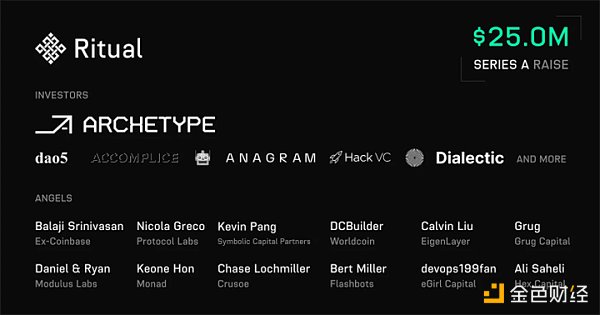
How to obtain a position: Join their Discord and stay tuned.
17. Nillion
Introduction: Nillion can train and reason AI models in a safe and confidential manner, creating the backbone of secure personalized AI.
Reasons to be optimistic: Nillion’s blind computing network unlocks many new use cases, among which personalized AI is a huge unlocked area. Personalized AI will not be widely adopted unless there is private data processing. Nillion's solution sounds like a real game changer.

How to obtain a position: Join their Discord and keep following. If you're a developer, I'm sure they'll be hosting some hackathons soon.
 JinseFinance
JinseFinance


















